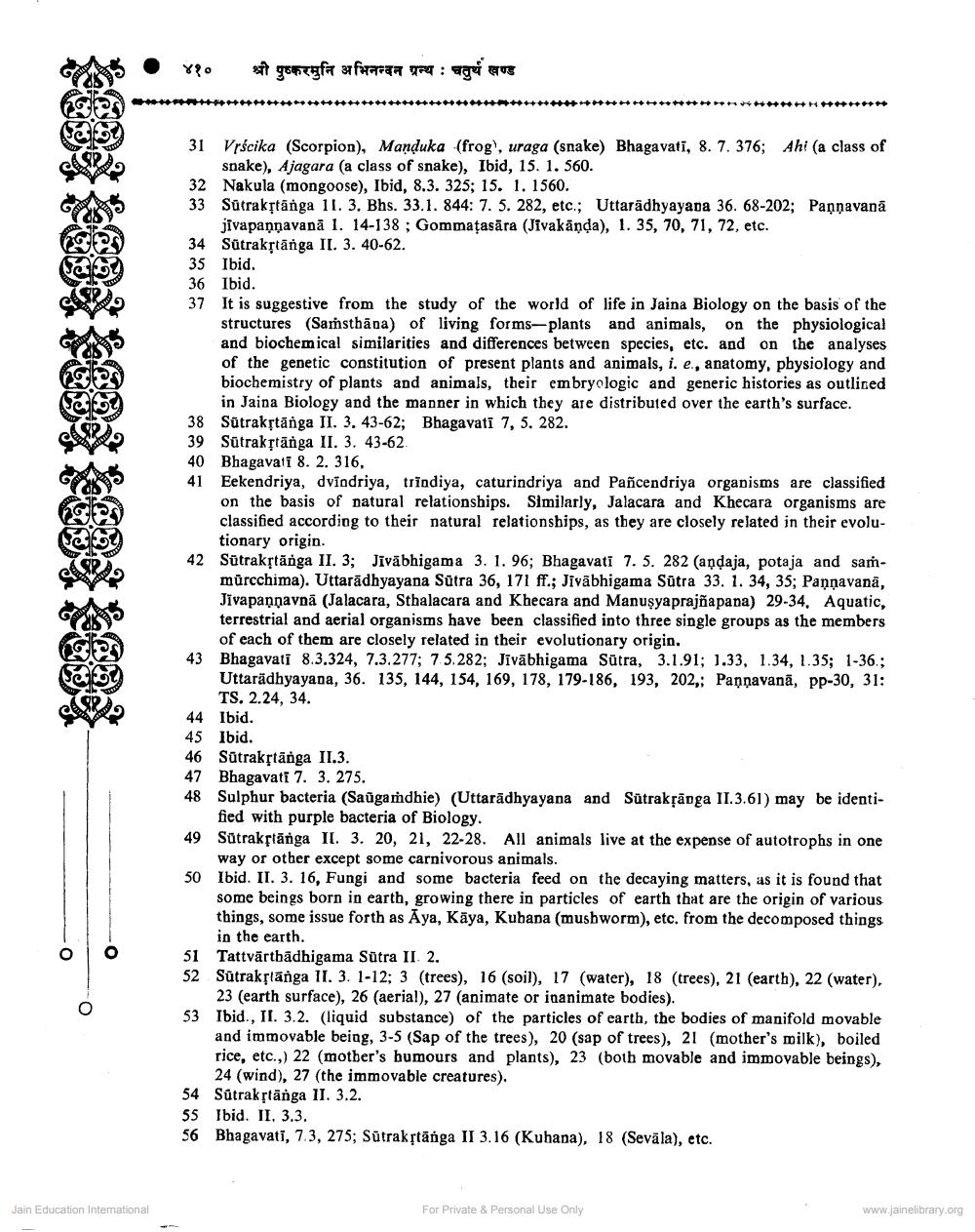________________
*$.
fit gon gf a
an
aghave
42
31 Vrścika (Scorpion), Manduka (frog', uraga (snake) Bhagavati, 8. 7. 376; Ahi (a class of
snake), Ajagara (a class of snake), Ibid, 15. 1. 560. 32 Nakula (mongoose), Ibid, 8.3. 325; 15. 1. 1560.
Sūtrakstānga 11. 3. Bhs. 33.1. 844: 7. 5. 282, etc.; Uttaradhyayana 36. 68-202; Paņņavanā
jivapaņnavanā 1. 14-138; Gommațasāra (Jivakāņda), 1. 35, 70, 71, 72, etc. 34 Sūtrakstānga II. 3. 40-62. 35 Ibid. 36 Ibid. 37 It is suggestive from the study of the world of life in Jaina Biology on the basis of the
structures (Samsthāna) of living forms-plants and animals, on the physiological and biochemical similarities and differences between species, etc. and on the analyses of the genetic constitution of present plants and animals, i. e., anatomy, physiology and biochemistry of plants and animals, their embryologic and generic histories as outlined
in Jaina Biology and the manner in which they are distributed over the earth's surface. 38 Sütrakstānga II. 3. 43-62; Bhagavati 7, 5. 282. 39 Sūtrakstānga II. 3. 43-62 40 Bhagavati 8. 2. 316, 41 Eekendriya, dviodriya, trindiya, caturindriya and Pancendriya organisms are classified
on the basis of natural relationships. Similarly, Jalacara and Khecara organisms are classified according to their natural relationships, as they are closely related in their evolutionary origin. Sūtrakstānga II. 3; Jivābhigama 3. 1. 96; Bhagavati 7. 5. 282 (andaja, potaja and sammürcchima). Uttaradhyayana Sutra 36, 171 ff.; Jiväbhigama Sutra 33. 1. 34, 35; Pannavana, Jivapaņņavnā (Jalacara, Sthalacara and Khecara and Manuşyaprajñapana) 29-34, Aquatic, terrestrial and aerial organisms have been classified into three single groups as the members
of each of them are closely related in their evolutionary origin. 43 Bhagavatī 8.3.324, 7.3.277; 7.5.282; Jivābhigama Sutra, 3.1.91; 1.33, 1.34, 1.35; 1-36.;
Uttaradhyayana, 36. 135, 144, 154, 169, 178, 179-186, 193, 202,; Pannavanā, pp-30, 31:
TS. 2.24, 34. 44 Ibid. 45 Ibid. 46 Sütrakstānga II.3. 47 Bhagavati 7. 3. 275. 48 Sulphur bacteria (Saūgamdhie) (Uttarādhyayana and Sūtrakļānga II.3.61) may be identi
fied with purple bacteria of Biology. 49 Sütrakstānga II. 3. 20, 21, 22-28. All animals live at the expense of autotrophs in one
way or other except some carnivorous animals. 50 Ibid. II. 3. 16, Fungi and some bacteria feed on the decaying matters, as it is found that
some beings born in earth, growing there in particles of earth that are the origin of various things, some issue forth as Aya, Kāya, Kubana (mushworm), etc. from the decomposed things
in the earth. 51 Tattvārthādhigama Sutra II. 2. 52 Sūtrakslanga II. 3. 1-12; 3 (trees), 16 (soil), 17 (water), 18 (trees), 21 (earth), 22 (water),
23 (earth surface), 26 (aerial), 27 (animate or inanimate bodies). 53 Ibid., II. 3.2. (liquid substance) of the particles of earth, the bodies of manifold movable
and immovable being, 3-5 (Sap of the trees), 20 (sap of trees), 21 (mother's milk), boiled rice, etc.,) 22 (mother's humours and plants), 23 (both movable and immovable beings),
24 (wind), 27 (the immovable creatures). 54 Sütrakştānga II. 3.2. 55 Ibid. II, 3.3. 56 Bhagavati, 73, 275; Sutrakstānga II 3.16 (Kuhana), 18 (Sevāla), etc.
Jain Education International
For Private & Personal Use Only
www.jainelibrary.org




